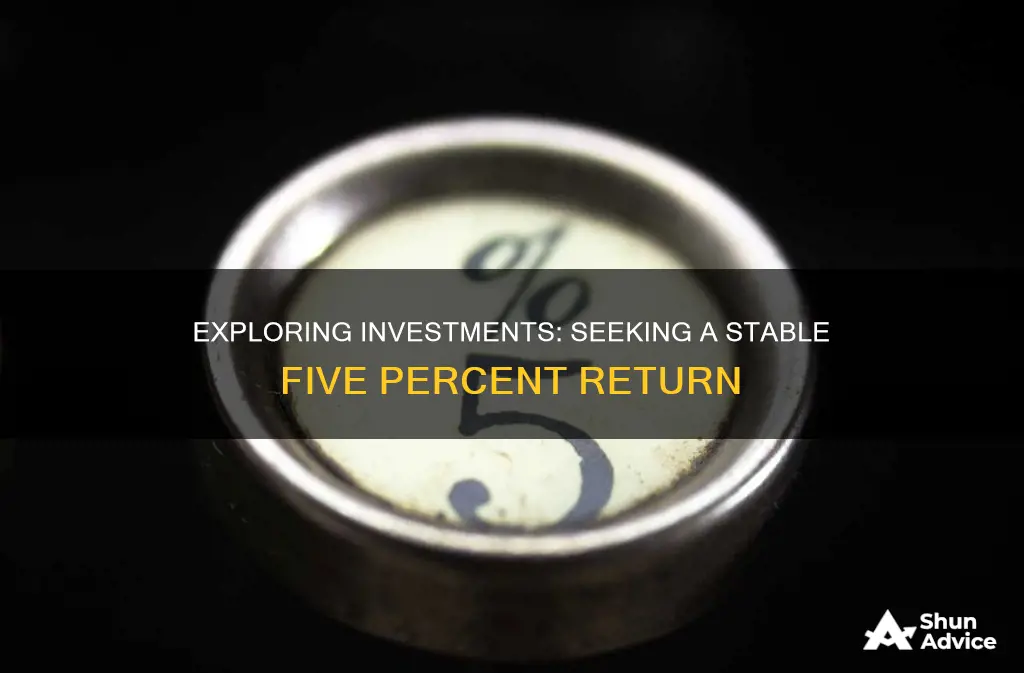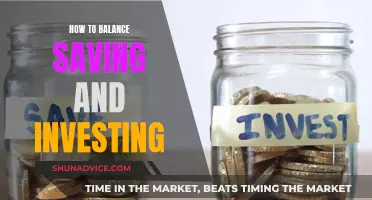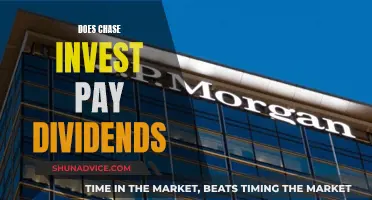
There are a variety of investment options that can yield a 5% return or more. While there is no completely safe way to earn a consistent 5% return, there are several low-risk options that can help investors achieve this goal. These include high-yield savings accounts, money market accounts, certificates of deposit (CDs), and Treasury securities.
For those willing to take on more risk, stocks, mutual funds, ETFs, bonds, and real estate investment trusts (REITs) can offer the potential for higher returns. It's important to remember that investing carries inherent risks, and there are no guarantees of specific returns. Diversifying one's portfolio across different asset classes can help mitigate risks and potentially increase the chances of achieving the desired returns.
| Characteristics | Values |
|---|---|
| High-yield savings accounts | 5% or more |
| Money market accounts | Similar to high-yield savings accounts |
| Certificates of deposit (CDs) | 5% or higher |
| Treasury securities | Slightly higher returns than CDs |
| Stock mutual funds and ETFs | S&P 500 ETF (SPY), iShares Core S&P 500 ETF (IVV), Vanguard S&P 500 ETF (VOO) |
| Bonds and Bond Mutual Funds | 5% or better |
| Real Estate Investment Trusts (REITs) | 8.8% per year over the last 15 years |
| Peer-to-Peer (P2P) Loan Investing | 4.5% median return on Lending Club |
| Annuities | 5% with certain annuities |
What You'll Learn

High-yield savings accounts
Benefits of High-Yield Savings Accounts
Drawbacks of High-Yield Savings Accounts
One potential drawback of high-yield savings accounts is that you may need to open an account with a new institution to earn the highest yields. Additionally, some accounts have withdrawal limits of six per month, and there may be fees or minimum balance requirements. It's important to carefully review the terms and conditions of each account before opening one.
Examples of High-Yield Savings Accounts
- Flagstar Bank offers a 5.55% APY with no required minimum opening deposit. However, there is a $15 monthly fee unless you maintain an average daily balance of $10,000 or have a Flagstar checking account.
- My Banking Direct offers a 5.45% APY with a $500 minimum opening deposit and no monthly maintenance fee.
- Forbright Bank offers a 5.30% APY with no minimum opening deposit or monthly maintenance fee. However, there is no ATM card available, and you can only access your funds by transferring them to a linked external checking account.
- UFB Direct offers a 5.25% APY with no minimum opening deposit or monthly maintenance fee.
Tips for Choosing a High-Yield Savings Account
When choosing a high-yield savings account, it's important to consider the APY, minimum opening deposit and balance requirements, monthly fees, and other features such as mobile check deposit and external transfer capabilities. It's also crucial to ensure that the bank or credit union is FDIC-insured or NCUA-insured.
In summary, high-yield savings accounts can be a great way to boost your savings and earn a competitive interest rate, but it's important to carefully review the terms and conditions before opening an account.
Retirement Planning: Invest More, Worry Less
You may want to see also

Money market accounts
Quontic Bank Money Market Account
Quontic Bank offers a stellar 5% APY, a very low opening minimum deposit of $100, and no maintenance fees. It also provides check-writing abilities and a debit card to access your cash easily. Quontic Bank has over 90,000 surcharge-free ATMs across the United States and offers various digital payment options, including Zelle, Apple Pay, Google Pay, and Samsung Pay.
Redneck Bank Mega Money Market Account
Redneck Bank, the online banking division of All America Bank, offers a vibrant and playful approach with its brand and website. Its Mega Money Market Account features an animated squirrel mascot and a high 4.75% APY. The account requires a minimum opening deposit of $500, and there are no maintenance fees. It includes a Mastercard debit card, checks, and up to six monthly withdrawals.
UFB Direct Money Market Account
UFB Direct, an online bank and division of Axos Bank, offers a high-yield savings account and money market account. Its money market account has one of the highest interest rates, with a 5.25% APY. This account charges a monthly maintenance fee of $10, but customers who maintain a balance of $5,000 or more get the fee waived. It also offers a debit card and check-writing privileges, along with the freedom of unlimited fund transfers.
Zynlo Bank Money Market Account
Zynlo Bank, backed by Massachusetts-based Peoples Bank, offers a money market account with a high 5% APY, a $10 minimum deposit, and no monthly maintenance fees. There are no monthly withdrawal limits, but this account does not provide check or debit card access. Zynlo Bank offers online and mobile banking services, allowing customers to manage their money from anywhere.
Northern Bank Direct Money Market Account
Northern Bank Direct is the online-only branch of Northern Bank, serving the financial needs of New England since 1960. Its money market account requires a higher minimum opening deposit of $5,000, but it offers a competitive 4.95% APY. There is no limit on the number of withdrawals, and customers have access to surcharge-free ATMs through the SUM network. Northern Bank Direct provides online and mobile banking services and does not charge monthly service fees.
Merchants Bank of Indiana Money Market Account
Merchants Bank of Indiana offers a money market account with a high APY of 5%, a low minimum deposit of $50, and no maintenance fees. Customers can access their funds with checks, but withdrawals are limited to six per statement cycle. The bank provides assistance through phone support and brick-and-mortar locations in Indiana.
Rethink's AI Appeal to Investors
You may want to see also

Short-term certificates of deposit
With short-term CDs, your money isn't locked in for an extended period. This flexibility makes short-term CDs ideal for saving towards short-term goals, such as a vacation or a large purchase. Additionally, if you expect CD rates to rise in the near term, short-term CDs allow you to take advantage of higher rates once your current CD matures.
When considering a short-term CD, it's important to keep in mind that they generally offer lower interest rates compared to long-term CDs. Banks often incentivize savers to choose long-term CDs by offering higher rates. However, short-term CDs can still provide competitive rates, especially in the current economic climate. As of August 2024, some banks are offering short-term CDs with APYs of up to 5%.
It's also worth noting that withdrawing money from a CD prior to its maturity date may result in early withdrawal penalties. These penalties can vary depending on the bank and the CD's term length, but they typically involve forfeiting some or all of the interest earned. Therefore, it's crucial to consider your financial goals and ensure that you won't need to access the funds during the CD's term.
Short-term CDs can be a great option for those seeking a safe and flexible investment with competitive interest rates. They allow you to grow your savings while providing the certainty of a fixed interest rate. By comparing offers from different banks and credit unions, you can find short-term CDs that align with your financial goals and help you maximize your returns.
Black Americans: Investors or Not?
You may want to see also

Stocks, Mutual Funds, and ETFs
Stocks are a popular investment choice because they have easily outperformed fixed-income investments over a long period of time. The average annual rate of return on stocks has been 10% since 1926. However, this is just an average, and the market can be volatile. There are years when the market is up 25%, and others when it's down 25%.
If you want to invest in stocks, you can hold individual stocks, but this requires considerable investment knowledge and can be costly in terms of fees. You would also need a large and diversified portfolio to manage the risk.
A better option for most investors is to invest in mutual funds or ETFs, which are portfolios of stocks. Mutual funds are typically actively managed and carry fees known as "loads", which can be as high as 3% of your investment principal. ETFs, on the other hand, are usually tied to an index of stocks and have lower investment fees and no load fees. With ETFs, you won't outperform the market, but you also won't underperform it. ETFs can be bought and sold like stocks and don't have minimum investment requirements.
Examples of popular ETFs include:
- SPDR S&P 500 ETF (SPY)
- IShares Core S&P 500 ETF (IVV)
- Vanguard S&P 500 ETF (VOO)
Mutual funds and ETFs can also be comprised of other types of investments, such as real estate investment trusts (REITs). REITs are like mutual funds, except they hold real estate instead of stocks. They typically invest in commercial property or large residential complexes. According to the MSCI US REIT Index, the average annual rate of return on REITs has been 16.1% over the past 10 years.
- Stocks:
- Enterprise Products Partners: This company owns pipelines, processing plants, and other oil and gas industry infrastructure. It has a dividend yield of 5.7%.
- Hospitality Properties Trust: One of the largest REITs focused on lodging, with a dividend yield of 6.4%.
- Oaktree Capital Group: An investment company that manages about $100 billion in alternative assets, with a dividend yield of 5.5%.
- Mutual Funds/ETFs:
- Global X SuperDividend ETF: An ETF that owns 98 high-yielding stocks, with a dividend yield of 6.8%.
- Putnam Premier Income Trust: A closed-end fund that holds a blend of mortgage-backed securities, junk bonds, and foreign debt, with a dividend yield of 6.0%.
- Van Eck Vectors Fallen Angel High Yield Bond ETF: An ETF that invests in "fallen angel" bonds that have lost their investment-grade ratings, with a dividend yield of 5.4%.
Investing: Nice People Turn Nasty
You may want to see also

Bonds and Bond Mutual Funds
Bonds are considered a safe investment option because their values don't fluctuate as drastically as stock prices. They offer investors a reliable stream of income and provide bondholders with a fixed form of income.
Bond Yield
The return realised by a bond investor is called the yield. The coupon rate and current yield are basic yield concepts and calculations.
- Coupon Yield: This is the annual interest rate established when the bond is issued. This figure remains the same for the lifetime of the bond.
- Current Yield: This figure depends on the bond's price and its coupon (or its interest payment). So if the price of the bond changes, the bond's yield also changes.
Bond Ratings
Bonds are rated by services approved by the Securities and Exchange Commission (SEC) and ratings range from "AAA" as investment grade with the lowest risk to "D," which are bonds in default, or junk bonds, with the highest risk.
Bond Mutual Funds
Bond mutual funds are an investment option that promises impressive cash flow, a relatively high degree of price stability, and instant diversification. They are sometimes called "junk bond funds," but they protect investors from significant default risk and loss of principal through corporate bankruptcies with wide diversification.
- American Funds American High-Income Trust Class F-1 (AHTFX)
- Fidelity Floating Rate High Income Fund (FFRHX)
- Fidelity Capital & Income Fund (FAGIX)
- American Funds Emerging Markets Bond Fund Class F-1 (EBNEX)
- T. Rowe Price Credit Opportunities Fund (PRCPX)
- American Century High Income Fund Investor Class (AHIVX)
- Northern Multi-Manager High Yield Opportunity Fund (NMHYX)
- Touchstone Ares Credit Opportunities Fund Class Y (TMAYX)
- Vanguard High-Yield Corporate Investor Shares (VWEHX)
- T. Rowe Price Intermediate Tax-Free High Yield Fund (PRIHX)
Unveiling the Art of Identifying Investment Opportunities for Projects
You may want to see also
Frequently asked questions
There are a few low-risk investments that can yield five percent, including high-yield savings accounts, money market accounts, and certificates of deposit (CDs).
There are several higher-risk investments that can yield five percent or more, such as stocks, mutual funds, and ETFs. However, it's important to remember that higher returns come with higher risk.
There is no guaranteed way to earn a risk-free return of five percent or higher. To achieve a five percent return, you will need to add some riskier investments to your portfolio.
Some alternative investments that can yield five percent or more include peer-to-peer lending, annuities, and real estate investment trusts (REITs). However, these investments come with their own set of risks and complexities.







